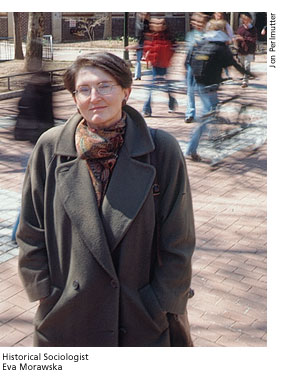
Taking Time Seriously
Historical Sociologist Plots Position
in the Torrent of Time

"She says the word time 4,000 times in every class,"
reports a student in Ewa Morawska’s course on the Uses of History
in the Global Society.
Two Humps
"I’m a two-hump camel," says
Morawska, "a historian and a sociologist—or a sociologist and
a historian." She holds appointments in both departments. "I
do historical sociology, which means precisely taking time seriously."
Morawska defected from Poland in 1980 before the Berlin Wall came down. Ask her about life under Communism, and she’ll respond, "Gray—monotonously gray, punctuated by continuous harassment in getting your daily bread, your daily milk, and your daily toilet paper—which was never there." Sunlight pours into blue and yellow bottles lined up along her windowsill, filling them with colored light. "I grew up in a dissident milieu, and even small children were aware of the surreal, double-decker reality—the real one and the official one created by what we called newspeak or propaganda."
Her scholarship tracks how mostly Eastern European immigrants adapted when they came to Western Europe and America in the late 19th and 20th centuries. "Their roads to integration were bumpy and full of twists and turns," she recounts, conflating their story with hers.
River of
Time
All things are unfixed by time. To be in time
means that nothing stays; everything is always in the act of becoming
something else. Taking time seriously means subscribing to what might
be called the Heraclitean school of sociology. Comparing the ceaseless
flux of life to a flowing river, Heraclitus of Ephesus (b. 535 BC) taught,
"you can’t step twice into the same river."
Morawska embraces the sentiment. "We live time; normally we don’t reflect on it," she says. "It flows through us. But I think it’s worthwhile to stop and reflect on what this means. One thing it means is conceiving of society and ourselves as dynamic processes of becoming, rather than as finished products."
 So
tightly bound are temporality and social life that you can tell the time
by looking at what’s happening around you. Just before nine o’clock,
an in-rushing tide of faculty and staff flows onto campus, and an ebb
tide runs out around five. Long lines form at campus snack trucks near
noon, when students sell tickets and set up information tables on Locust
Walk. Sophisticated observers who know their friends’ course schedules
can estimate what period has ended by noting who is being swept along
on the waves of students that, all day long, wash back and forth across
the campus. "I would argue," says Morawska, "that a certain
rhythm or regularity of events and happenings is a precondition for society
to exist."
So
tightly bound are temporality and social life that you can tell the time
by looking at what’s happening around you. Just before nine o’clock,
an in-rushing tide of faculty and staff flows onto campus, and an ebb
tide runs out around five. Long lines form at campus snack trucks near
noon, when students sell tickets and set up information tables on Locust
Walk. Sophisticated observers who know their friends’ course schedules
can estimate what period has ended by noting who is being swept along
on the waves of students that, all day long, wash back and forth across
the campus. "I would argue," says Morawska, "that a certain
rhythm or regularity of events and happenings is a precondition for society
to exist."
Pacing Ourselves
For the historical sociologist, time—how
fast it flows, when things happen and in what order, the rhythm
and duration of occurrences—is a major parameter in the social world.
"Take a dimension of time such as pace," Morawska explains.
"For millennia, societies lived by the time of seasons. We live by
clock time, and it has revolutionized our lives."
Peasant immigrants who came ashore in America a century ago walked to the factory at sunrise, and to the fury of their bosses, would take naps at midday, just as they used to in the fields of their home countries. It was a head-on collision of time conventions—agricultural vs. industrial.
"Well, very brutally, they were taught—by the loss of wages, if not jobs—that you punched in at five o’clock sharp and not 5:05," Morawska narrates. "And there was no leaving at noon. The sun didn’t matter here. The clock mattered." And that clock has been ticking faster and faster ever since.
It used to be that remaining with an employer for a long time was considered a sign of a stable and committed worker. What was once thought of as loyalty can today be seen as a shortcoming. To be deemed employable now, workers often must demonstrate their flexibility by moving repeatedly from one job or career to another. What does this do to loyalty and commitment, and is the company better off if it is always in flux? No one knows the answers, says Morawska.
For Americans, she observes, newer and quicker have long been prime values. Tell Americans to buy something because it’s new or to do something a different way because it’s faster, and you’ve presented a convincing argument. People from other cultures, she points out, would wait for you to tell them more. "For Americans, this is enough. We grab it and run."
This novelty and future-facing approach to life allowed the United States to go from a beachhead colony to a world economic power in a very short time. "So it would be foolish to deny the developmental advantages of this running ahead of ourselves," she offers.
Still, Morawska seems troubled by the white-water ride our society has embarked upon, particularly the ever-increasing pace of life and the stress resulting from the spread of the Internet. Five years ago, she would typically receive about a dozen e-mails a day. Now she gets about 70, and many clamor for immediate replies. Students, she has noticed, spend more and more time online, socializing, for instance, in chatrooms.
 The
Net facilitates wider communication but it accelerates life; it opens
up the world but it’s also intrusive. "We’re galloping
into this world as if it were a self-evident blessing," she contends.
"It’s newer and quicker, so of course it must be ‘good,’
but we do not reflect on the implications for friendship, for the duration
of social contacts, for knowing each other, for loyalty and commitment.
I think it’s time we started talking about what’s happening
and about the balance of advantages and disadvantages of this ongoing
revolution.
The
Net facilitates wider communication but it accelerates life; it opens
up the world but it’s also intrusive. "We’re galloping
into this world as if it were a self-evident blessing," she contends.
"It’s newer and quicker, so of course it must be ‘good,’
but we do not reflect on the implications for friendship, for the duration
of social contacts, for knowing each other, for loyalty and commitment.
I think it’s time we started talking about what’s happening
and about the balance of advantages and disadvantages of this ongoing
revolution.
"You understand," she cautions, "it seems to be happening to us, rather than with us."
Is there a limit to how fast humans can live? "I’m a pre-modern woman," Morawska quips, "a dinosaur." She’s not "against" technology; she simply respects it’s power to shape our time, our world, and who we are. If we’re going to shoot the rapids, she seems to be saying, we should first understand them and have an idea of where we’re being taken, and not just let ourselves be swept away by the torrent.